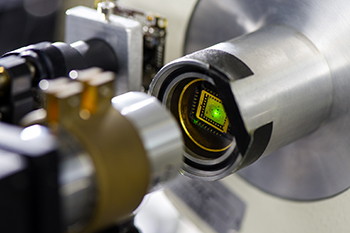
A chip of graphene with gold strips and nitrogen-vacancy nanodiamonds on top may be a good candidate for a “read head” in quantum computers. Credit: Astrid Eckert / TUM
Operational quantum computers are only a decade away, according to many physicists in the field, and nitrogen-vacancy centers in diamond are a promising way to implement a sensor or register component for such a system. However, one barrier is the ability to read out the stored optical information from such a nitrogen-vacancy-based system. Materials researchers in Europe have devised a way to read the stored information using direct energy transfer from nitrogen-vacancy centers in diamond nanocrystals on a layer of graphene (Nat. Nano., doi: 10.1038/nnano.2014.276).
In the experiment, laser light shined on a nanodiamond with a central defect (comprised of a nitrogen atom and a vacancy) excites an electron, creating a dipole from the excited electron and the vacated ground state. This likewise induces a corresponding dipole in the graphene layer, the charge of which can be measured because graphene is electrically conducting.
Professor of experimental physics Alexander Hollleitner at the Technische Universität München (TU München) in Munich, Germany, and Frank Koppens, professor of physics at the Institut de Ciencies Fotoniques near Barcelona, Spain, and colleagues developed nanocircuits with extremely fast switching speeds, consisting of 100-nm diamonds on top of a graphene layer overlaid with two gold electrodes to detect the induced charge. The group was able to detect currents with picosecond time resolution (trillionths of a second) to read out transferred electron excitations in the graphene. Ultrafast readout is important because the electron-vacancy pairs are generated for only a few billionths of a second.
“In principle, our technology is so sensitive that we should also be able to measure individual dye molecules,” said doctoral candidate and first author Andreas Brenneis at TU München in a press release.
The results may pave the way for incorporation of nitrogen-vacancy centers into ultrafast electronic circuits for quantum computers and for electronic read-out of non-radiative transfer processes.
